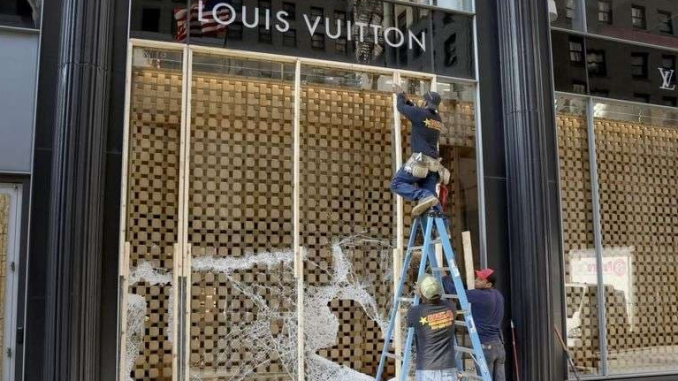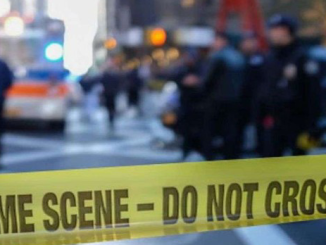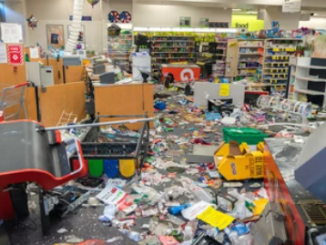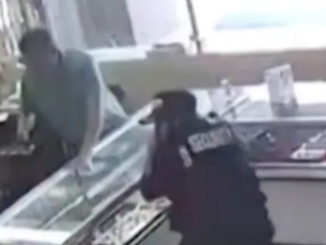
Workers begin to board up a display window at the Louis Vuitton store Monday, Aug. 10, 2020, after overnight vandals hit many high-end stores in Chicago.Photo by: AP Photo/Teresa Crawford
Rampant shoplifting and organized retail theft, often unchecked by local governments and allowed to grow into a multibillion-dollar business, have major retailers turning to Washington for help.
Legislation aimed at the problem, however, has yet to turn the tide of the shoplifting scourge.
{snip}
It’s a problem from coast to coast.
Michigan Attorney General Dana Nessel recently announced a series of arrests in flash mob thefts at Lululemon and Ulta locations.
A security guard in Philadelphia was fatally stabbed and a second guard was injured by a man robbing a Macy’s this month. The suspect had been arrested more than a dozen times for retail theft and other offenses.
Target recently said it would close nine stores across four cities — New York, Seattle, San Francisco and Portland, Oregon — because of fear for employee and customer safety around organized theft, and Walmart this fall opened a “police workspace” at one of its Atlanta stores to deter crime.
The companies say it is far too easy for thieves to swipe “smart” devices for homes and other in-demand goods and sell them online.
“From our perspective, things are not really changing. We’ve seen [organized retail crime] cases continue to grow not only in volume and velocity but in size and scope, year over year,” Scott Glenn, the vice president for asset protection at Home Depot, told The Washington Times.
{snip}
“Large organizations of professional shoplifters or ‘boosters’ are exploiting soft-on-crime policies to ransack American businesses and carry out an unprecedented spike in retail crime,” Rep. August Pfluger, Texas Republican said at a recent congressional hearing.
He cited the trade group Retail Industry Leaders Association’s estimate that organized crime costs retailers $70 billion per year.
Getting reliable statistics on the problem can be difficult. The National Retail Federation retracted part of a recent report due to an analyst’s error and some critics accuse corporations of exaggerating the problem to justify store closures.
Elected leaders are under pressure to do something. California Gov. Gavin Newsom responded to smash-and-grab thefts in 2021 by issuing a get-tough call for stiffer prosecutions and more money in the state budget to target the problem.
Florida Gov. Ron DeSantis, a Republican candidate for president, signed a bill last year that created second-degree and third-degree felony crimes for people who commit repeated thefts within a short period.
Former President Donald Trump raised eyebrows in October by saying shoplifters should be shot on the spot.
{snip}
Retailers are lobbying Congress to pass the Combatting Retail Crime Act that would establish the Organized Retail Crime Coordination Center through the Department of Homeland Security. It would coordinate federal efforts, establish relationships with state and local law enforcement and set up a secure system to share data and spot trends.
Mr. Glenn described the proposed center as a “one-stop shop” for combating organized retail theft, especially for thieves who cross state lines.
“We need a task force that dedicates some agency within the government to take point on this issue,” he said.
Shocking footage of teenagers or others looting stores en masse often makes the evening newscasts. For example, a group of looters ransacked a Chanel store in downtown Washington several days before Christmas, making off with armloads of luxury handbags. It was the second time the store was hit in 2023.
Meanwhile, a steady drip of quieter, organized thefts is taking a bite out of retailers.
Organized fencers enlist people, known as boosters, to go into stores and slip items into their bags or clothing. The thieves get a cut of the proceeds once they turn the products over to gangs that sell the goods online.
“A lot of times these folks come from some vulnerable populations. They may be drug-addicted. They may be unhoused,” Mr. Glenn said. “Certainly, the fences and the higher-ups within these organized groups prey on those types of populations and use them for that piece of it.”
Experts say the problem is fueled by the ease of setting up a fly-by-night operation online to move goods.
The criminal rings are “driven by greed and opportunity, not so much location and geographic region,” Michael Krol, a special agent in charge for Homeland Security Investigations in New England, told the House Homeland Security Subcommittee on Counterterrorism, Law Enforcement and Intelligence.
{snip}
At Home Depot, Mr. Glenn said thieves tend to target copper wiring and wifi-enabled “smart” devices such as dimmer switches that connect to the internet. The product is sent to centralized locations, cleaned up so it doesn’t look stolen — removing security tags, etc. — and posted for sale on internet marketplaces.
“Pretty much all of the online resellers are vulnerable to this and some do a better job of policing it than others,” Mr. Glenn said. “But at the end of the day, you know, the volume is such that it’s very hard to keep up with.”
Abby Jagoda, vice president of public policy for the International Council of Shopping Centers, said organized syndicates steal a range of in-demand items, from designer handbags to name-brand laundry detergent.
“When these goods are resold using an online marketplace or other means of sale, most consumers are unaware that they’re purchasing stolen goods,” she said.
President Biden last year signed the INFORM Act, which requires Amazon and other online marketplaces to gather contact information, tax IDs and other records from high-volume sellers. The hope is it injects enough sunlight into the selling process to ensure online markets do not unwittingly facilitate gangs that fence stolen goods.
Retailers called it a good first step.
The extent of the retail theft problem has been misstated at times, making it hard for policymakers to get a full snapshot of the problem.
{snip}
Still, lawmakers in both parties agree the problem is real and damaging.
Rep. Dina Titus, Nevada Democrat, said she once saw a person stealing fake eyelashes from a Walgreens, though a clerk said the store ordered employees not to intervene for safety reasons.
“Eyelashes are not power tools, I’ll give you that, but look around, there’s certainly a market for it. And they don’t sell it directly, they sell it to a swap meet or something,” she said.
David Johnston, vice president of asset protection and retail operations at NRF, told Congress that thieves tend to target areas with higher felony thresholds, low penalties for theft or places lacking police resources. He, too, is pushing Congress to create a federal entity focused on organized retail crime.
“With federal coordination, collaboration, support and resources, we can bring the fight to these organized groups across our nation,” he said.
* Original Article:
https://www.washingtontimes.com/news/2024/jan/1/organized-crime-blamed-for-nationwide-scourge-of-s/?utm_source=smartnews.com&utm_medium=smartnews&utm_campaign=smartnews%20


